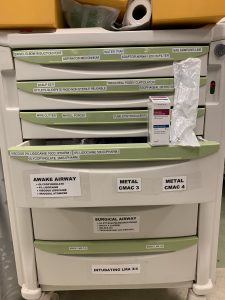Your patient has an SBO and has repeated bilious emesis on the side. The surgery team is in the OR and they ask if you can place the nasogastric tube (NGT). Lets review proper NGT placement and some new techniques that can facilitate placement.
SUPPLIES
cup of water with a straw
emesis basin
lubricant
NGT: the larger the better, but grab various sizes (12 – 18 fr.) try to warm this up under some warm water or put it in your pocket for a bit while you gather supplies. warming the tube increases its pliability.
60 ML bulb syringe
bottle of Normal Saline
wall suction set to low continuous or intermittent and suction tubing
tape (and benzoin if you’re fancy)
you can also try to topically anesthetize the area with lidocaine (as if you were prepping for an awake intubation).
PATIENT PREPARATION
Talk the patient through the steps. Sit them upright and give them the basin. Tell them to keep their chin to their chest, and when they feel the tube in the posterior oropharynx, they should start sipping water from the straw. You can support this position by placing (or having your assistant place) one hand on the back of the patient’s head.
Prime the tip of the tube with lidocaine. You can also prep the back of the throat with nebulized 4% lidocaine. As per our own Dr. Katari, atomized lidocaine also works very well. We have the atomizers in the critical care areas. See the picture below for reference. I have personally never nebulized or atomized lidocaine prior to NGT placement, but I’ll definitely give it a try next time.
As per aliem.com, using 5-mL of 4% topical lidocaine solution via nebulizer will provide a total dose of 200 mg, which is within the range of safe doses, and may provide the anesthetic effect you (and the patient) desires. Even if a second or third neb is needed, lidocaine serum concentrations should remain in the safe range. These doses should apply to the atomizer as well.
PLACEMENT:
Introduce the tube along the floor of the nostril. Do not insert the tube in an upward or lateral direction. The patient should swallow once they feel the tube in the back of the oropharynx. Advance the tube somewhere between 50-65 cm (try to estimate the distance from nose to stomach prior to this step).
If at any time, you feel significant resistance, or the patient starts coughing excessively, has respiratory distress, or significant nasal hemorrhage, STOP.
Gastric contents will likely enter the tube right away if your patient has a severe SBO. If not, try to insert air into the tube and auscultate over the stomach. If you hear the air, you’re in the right place.
Connect the tube to suction. Tape it in place. Thank your patient for their cooperation. Give yourself pat on the back.

